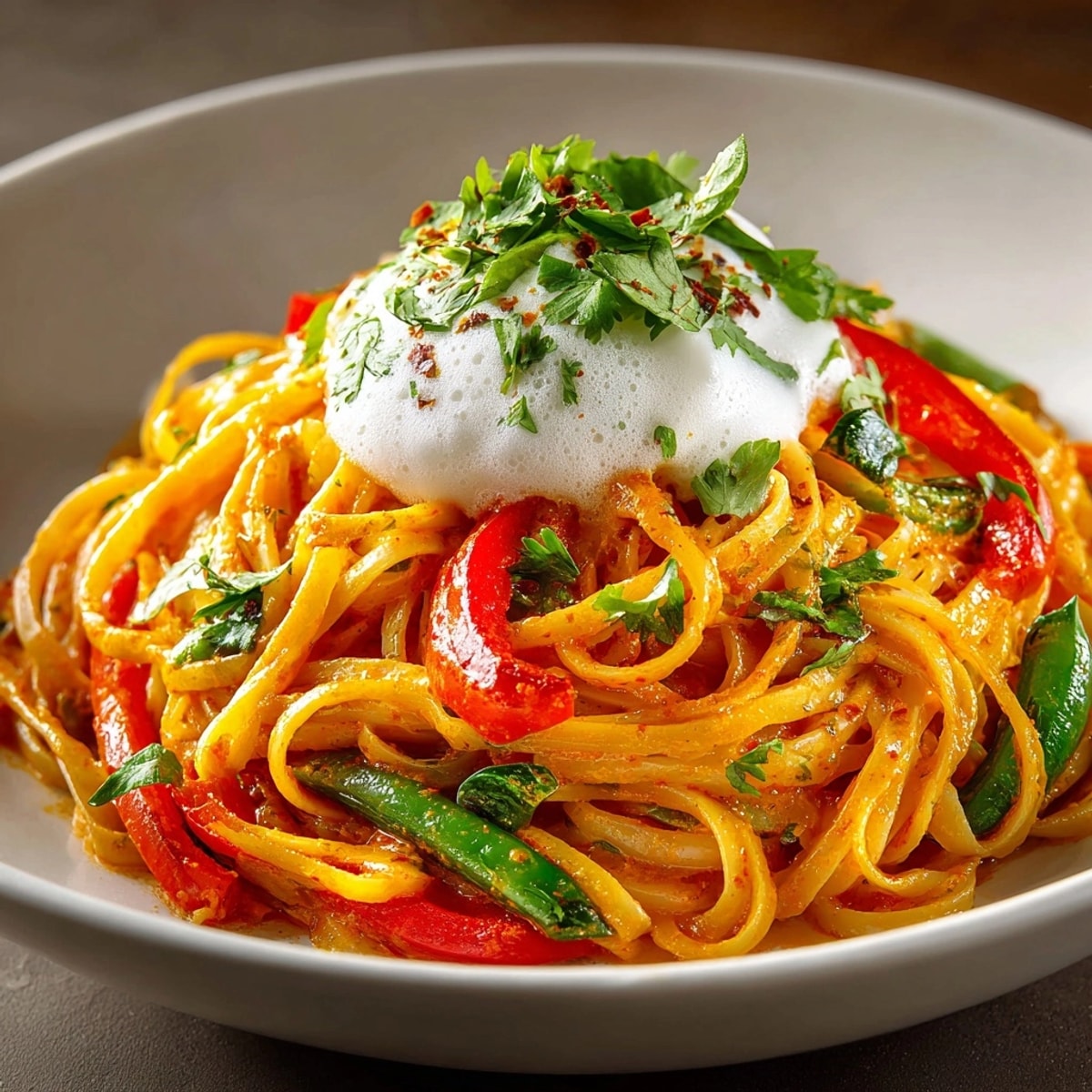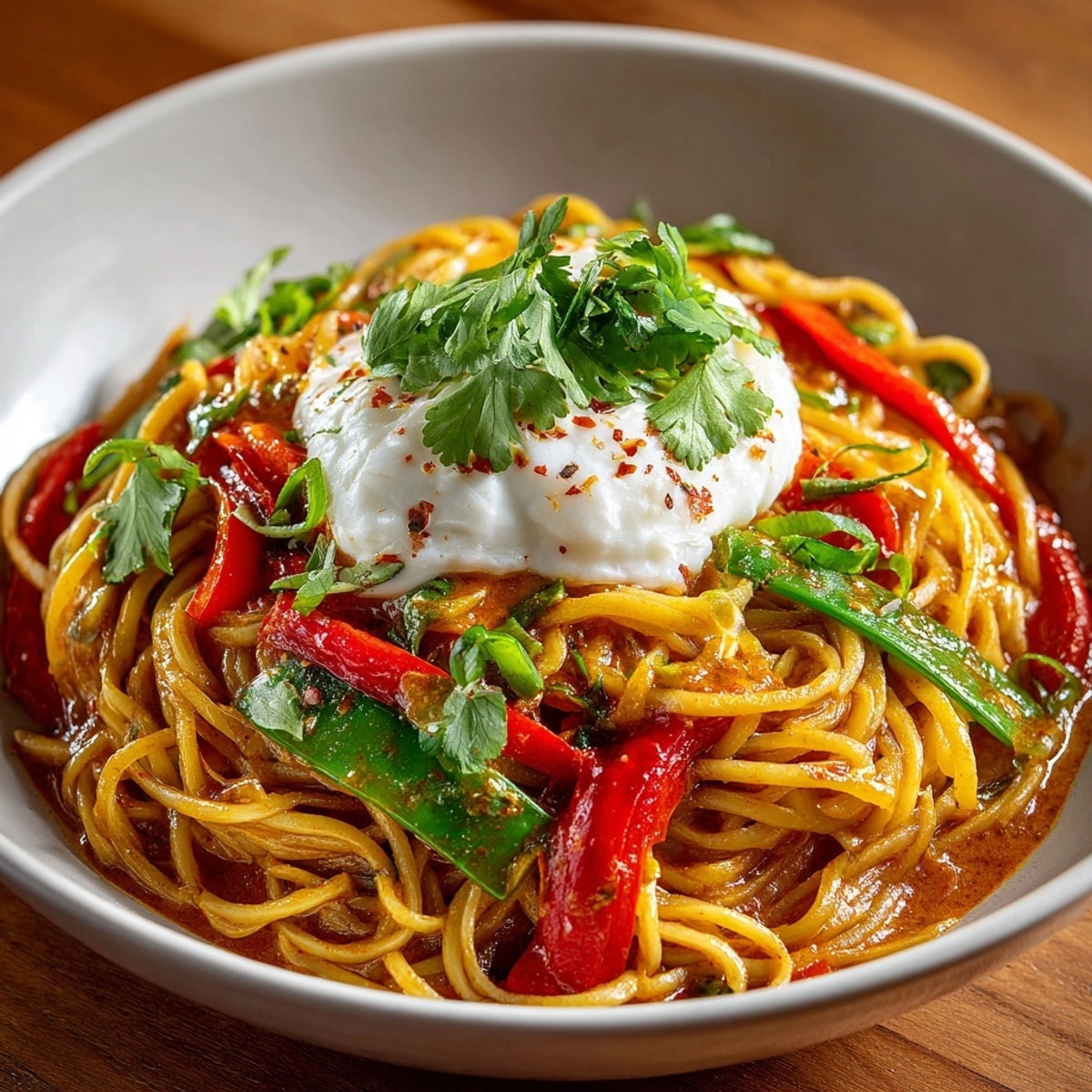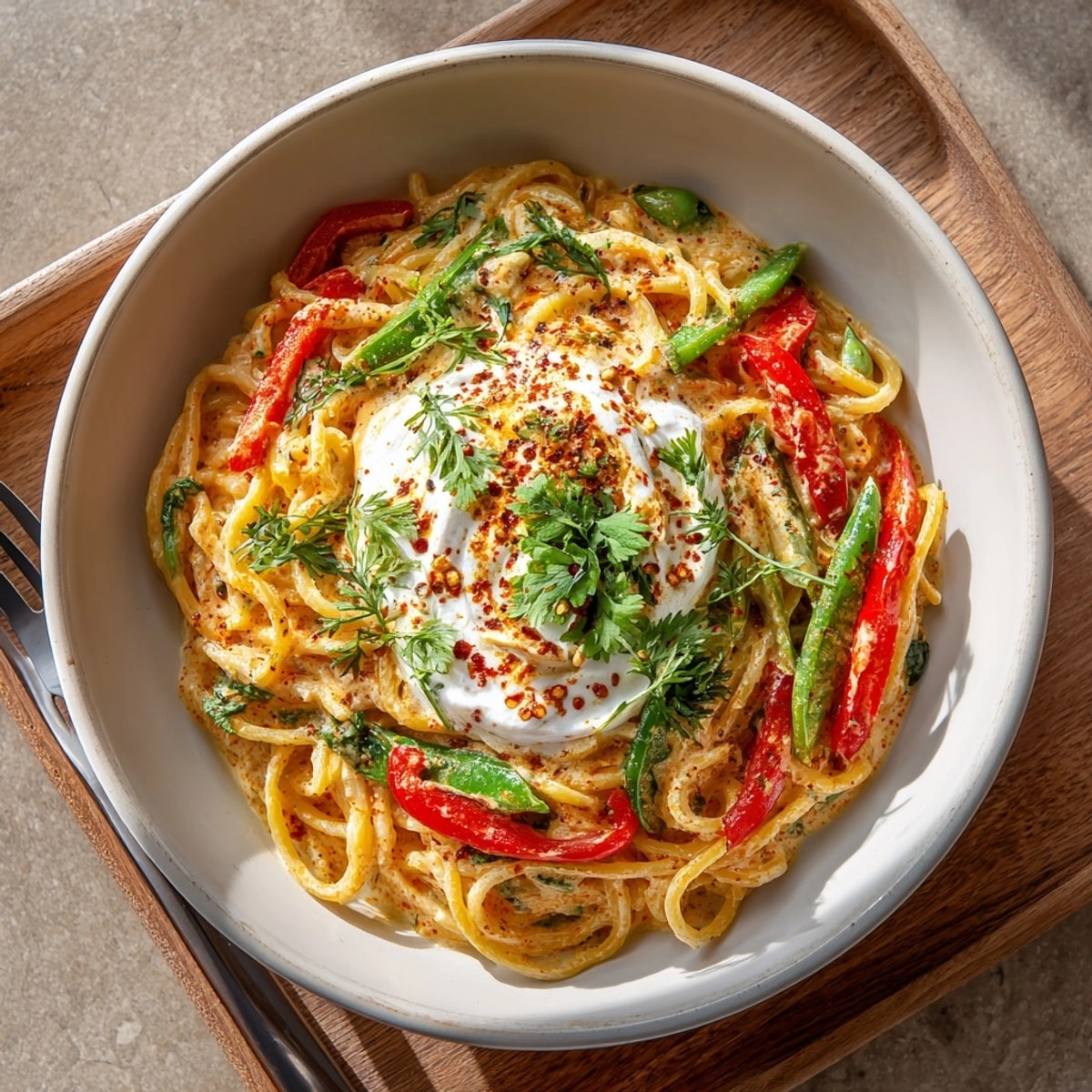 Pin
Pin This Thai curry pasta brings together two culinary worlds in perfect harmony. The aromatic spices of Thailand meet Italian comfort food, creating a dish that's both familiar and excitingly different. The coconut milk foam adds a touch of culinary elegance while keeping the dish approachable for home cooks.
I first created this fusion dish when craving both Thai takeout and pasta night simultaneously. Now it's become our Friday tradition, with my partner requesting the "fancy foam pasta" whenever we have guests to impress.
Ingredients
- linguine or spaghetti: 350g Quality matters here as it's the foundation of the dish
- vegetable oil: 2 tbsp A neutral oil works best to let the curry flavors shine
- onion: 1 medium finely chopped Creates the aromatic base for our sauce
- garlic: 2 cloves minced Fresh provides the best flavor punch
- fresh ginger: 1 tbsp grated Look for firm pieces with smooth skin
- Thai red curry paste: 2 tbsp Mae Ploy or Maesri brands offer authentic flavor
- red bell pepper: 1 thinly sliced Adds sweetness and vibrant color
- snap peas: 200g trimmed Choose bright green crisp pods
- coconut milk fullFat: 400ml Essential for a rich creamy sauce
- soy sauce: 1 tbsp Adds umami depth and saltiness
- brown sugar: 1 tsp Balances the heat and acidity
- lime: Juice of 1 Fresh is non-negotiable here
- Fresh coriander: for garnish The bright finish that ties everything together
- coconut milk chilled fullFat: 200ml Must be very cold for the best foam
- soy lecithin powder: 1/2 tsp Optional but creates a more stable foam
- Salt: for pasta water and foam Season generously for proper pasta cooking
Instructions
- Cook the Pasta:
- Bring a large pot of water to a rolling boil and add a generous amount of salt until it tastes like sea water. Add the pasta and cook according to package instructions until perfectly al dente. Before draining reserve a quarter cup of the starchy cooking water which will help bind our sauce later. Drain pasta but do not rinse as the starches help the sauce adhere.
- Create the Aromatic Base:
- Heat vegetable oil in a large wide skillet over medium heat until shimmering but not smoking. Add the finely chopped onion and cook for 3 full minutes stirring occasionally until they become translucent and soft. Add the minced garlic and grated ginger cooking for exactly one minute while stirring constantly to prevent burning. The kitchen should fill with an incredible fragrance at this point.
- Develop the Curry Flavor:
- Add the Thai red curry paste to the aromatics and stir constantly for 2 minutes. This crucial step blooms the spices in the oil releasing their full flavor potential. You'll notice the color deepening and the aroma becoming more intense. If the mixture seems dry add a splash of coconut milk early.
- Cook the Vegetables:
- Add the sliced bell pepper and snap peas to the skillet stirring to coat them in the curry mixture. Cook for just 2 minutes as we want them to retain some crispness and vibrant color. They'll continue cooking gently in the next step.
- Create the Silky Sauce:
- Pour in the coconut milk soy sauce and brown sugar stirring to combine everything thoroughly. Allow the mixture to come to a gentle simmer not a boil and cook for 5 minutes. The sauce should thicken slightly and the vegetables should become tender while still maintaining some bite.
- Combine Pasta and Sauce:
- Add the drained pasta directly to the skillet with the sauce. Using tongs gently toss everything together ensuring each strand gets evenly coated. If the sauce seems too thick add a splash of the reserved pasta water until you reach a silky consistency. Squeeze fresh lime juice over everything and toss once more.
- Create the Coconut Foam:
- In a tall narrow container combine the chilled coconut milk soy lecithin if using and a small pinch of salt. Using an immersion blender blend at an angle with the head partially above the surface to incorporate air. Continue until you have a light airy foam about 1 to 2 minutes. Work quickly as the foam is best used immediately.
- Plate and Garnish:
- Twirl portions of the pasta into shallow bowls creating a slight mound. Spoon the coconut foam generously on top allowing it to partially melt into the hot pasta. Scatter fresh coriander leaves over everything and serve immediately while the contrast between hot pasta and cool foam is at its peak.
 Pin
Pin The red curry paste is truly the heart of this dish. I discovered its transformative power during a cooking class in Bangkok years ago. Our instructor showed us how proper blooming of curry paste in oil unlocks layers of flavor impossible to achieve otherwise. That small technique changed my entire approach to Thai cooking at home.
Storage and Reheating
The pasta and curry sauce store beautifully in an airtight container in the refrigerator for up to 3 days. When reheating add a splash of water or coconut milk to loosen the sauce as it will thicken considerably when chilled. Warm gently on the stovetop rather than microwaving for best texture preservation. The coconut foam unfortunately cannot be stored and must be made fresh just before serving.
Protein Additions
While delicious as a vegetarian dish this Thai curry pasta welcomes protein additions beautifully. For chicken cut boneless thighs into bite sized pieces and sauté them after the aromatics but before adding curry paste until just cooked through. For shrimp add them to the simmering sauce about 3 minutes before serving until they turn pink and opaque. For a vegetarian protein boost add firm tofu cubes that have been pressed dried and pan fried separately then folded in at the end.
Cultural Context
This dish represents the growing trend of thoughtful fusion cuisine that honors both culinary traditions rather than simply combining them haphazardly. The Thai red curry provides complex aromatics while the pasta offers familiar comfort. The foam technique borrows from modern gastronomy creating an elevated experience without requiring professional equipment. When sharing this dish I like to explain how it represents the joy of culinary exploration and breaking traditional boundaries while respecting authentic techniques from both cuisines.
Seasonal Adaptations
Summer Version Use zucchini ribbons instead of snap peas and add halved cherry tomatoes at the end for freshness Fall Adaptation Incorporate diced butternut squash cooking it longer until tender and add sage leaves to the garnish Winter Comfort Add thinly sliced kale during the simmering stage for heartiness and nutrition
Success Stories
Many home cooks report this being their first successful attempt at creating a restaurant quality foam garnish. The simple immersion blender technique makes what seems like a cheffy trick accessible to anyone. Several readers have mentioned that this dish has become their signature entertaining recipe especially for guests who appreciate both Thai and Italian cuisines but have never experienced them together. The dramatic presentation with the foam consistently impresses dinner party guests.
 Pin
Pin Always taste and adjust your curry sauce before adding the pasta. The perfect balance should have heat spice sweetness and acidity in harmony. If it tastes flat add more lime juice if too spicy add a touch more coconut milk or sugar. For the most stable foam chill your coconut milk and equipment in the refrigerator for at least an hour before preparing. When making the foam work quickly and serve immediately as it will begin to deflate after about 5 minutes. The contrast between the hot pasta and cool foam creates a magical temperature and texture experience that makes this dish truly special.
Recipe Q&A
- → How do I make the coconut milk foam light and stable?
Use well-chilled full-fat coconut milk and, for best results, add soy lecithin powder before frothing with an immersion blender.
- → Can I use another type of pasta?
Yes, any long pasta such as spaghetti, tagliatelle, or rice noodles works. Adjust cooking times as needed for texture.
- → Is this dish spicy?
It's moderately spicy thanks to the Thai curry paste. Adjust the amount to suit your preferred heat level.
- → Can I add protein to the dish?
Absolutely. Tofu, shrimp, or chicken can be added. For tofu, sauté until golden; for meat, ensure it's fully cooked through.
- → How do I make this meal vegan?
Verify that your curry paste contains no shrimp paste or fish sauce, and use plant-based pasta for a complete vegan option.
- → What can I serve with this fusion pasta?
Pair with a crisp Riesling or a chilled Thai iced tea for a refreshing balance to the bold flavors.